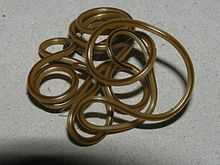Enoplea
| Enoplea | |
|---|---|
 | |
| Mermis nigrescens | |
| Scientific classification | |
| Kingdom: | Animalia |
| Phylum: | Nematoda |
| Class: | Enoplea |
| Subclasses | |
Enoplea is a class of nematodes, one of two classes that make up the phylum Nematoda in current taxonomy.[1][2][3] It is considered to be a more ancestral group than the other class, Chromadorea, and researchers have referred to its members as the "ancestrally diverged nematodes", compared to the "more recently diverged nematodes" of Chromadorea.[4]
Description
Enoplea are distinguished from Chromadorea by a number of characteristics. The enoplean esophagus is cylindrical or "bottle-shaped", compared to the bulbous chromadorean esophagus. Enopleans have pocket-like amphids, while chromadoreans have amphids shaped like slits, pores, coils, or spirals. An enoplean is smooth or marked with fine lines, while a chromadorean may have rings, projections, or setae. The enoplean excretory system is simple, sometimes made up of a single cell, while chromadoreans have more complex, tubular systems, sometimes with glands.[5][6]
Ecology
Several orders of enopleans are mainly freshwater animals, and several include marine species.[7]
Many enopleans are parasites of plants and animals, including humans. The orders Triplonchida and Dorylaimida include plant parasitic nematodes that are vectors of plant pathogens. The orders Mermithida and Marimermithida include parasites of invertebrates. The orders Dioctophymatida, Trichinellida, and Muspiceida include parasites of vertebrates such as birds and mammals. Examples are Trichinella spiralis, a nematode known for causing trichinosis in humans who consume it in undercooked pork, and whipworms (genus Trichuris), which are parasites of mammals, including cats, dogs, and humans.[5]
Diversity
As of 2012, Enoplea is divided into two subclasses and ten orders.[5]
Subclasses and orders include:[5]
- Subclass Enoplia
- Order Enoplida
- Order Triplonchida
- Subclass Dorylaimia
- Order Dorylaimida
- Order Mermithida
- Order Mononchida
- Order Dioctophymatida
- Order Trichinellida
- Order Isolaimida
- Order Muspiceida
- Order Marimermithida
References
| Wikimedia Commons has media related to Enoplea. |
| Wikispecies has information related to: Enoplea |
- ↑ Phylum Nematoda. Nemaplex: Nematode-Plant Expert Information System. University of California, Davis. Version October 4, 2012.
- ↑ Jühling, F., et al. (2012). Armless mitochondrial tRNAs in Enoplea (Nematoda). RNA Biology 9(9), 1161–66.
- ↑ Hyman, B. C., et al. (2011). Rampant gene rearrangement and haplotype hypervariation among nematode mitochondrial genomes. Genetica 139(5), 611-15.
- ↑ Schulze, J. and E. Schierenberg. (2009). Embryogenesis of Romanomermis culicivorax: An alternative way to construct a nematode. Developmental Biology 334(1), 10-21.
- ↑ 5.0 5.1 5.2 5.3 Class Enoplea. Nemaplex: Nematode-Plant Expert Information System. University of California, Davis. Version October 9, 2012.
- ↑ Class Chromadorea. Nemaplex: Nematode-Plant Expert Information System. University of California, Davis. Version October 4, 2012.
- ↑ Tahseen, Q. (2012). Nematodes in aquatic environments: adaptations and survival strategies. Biodiversity Journal 3(1) 13-40.